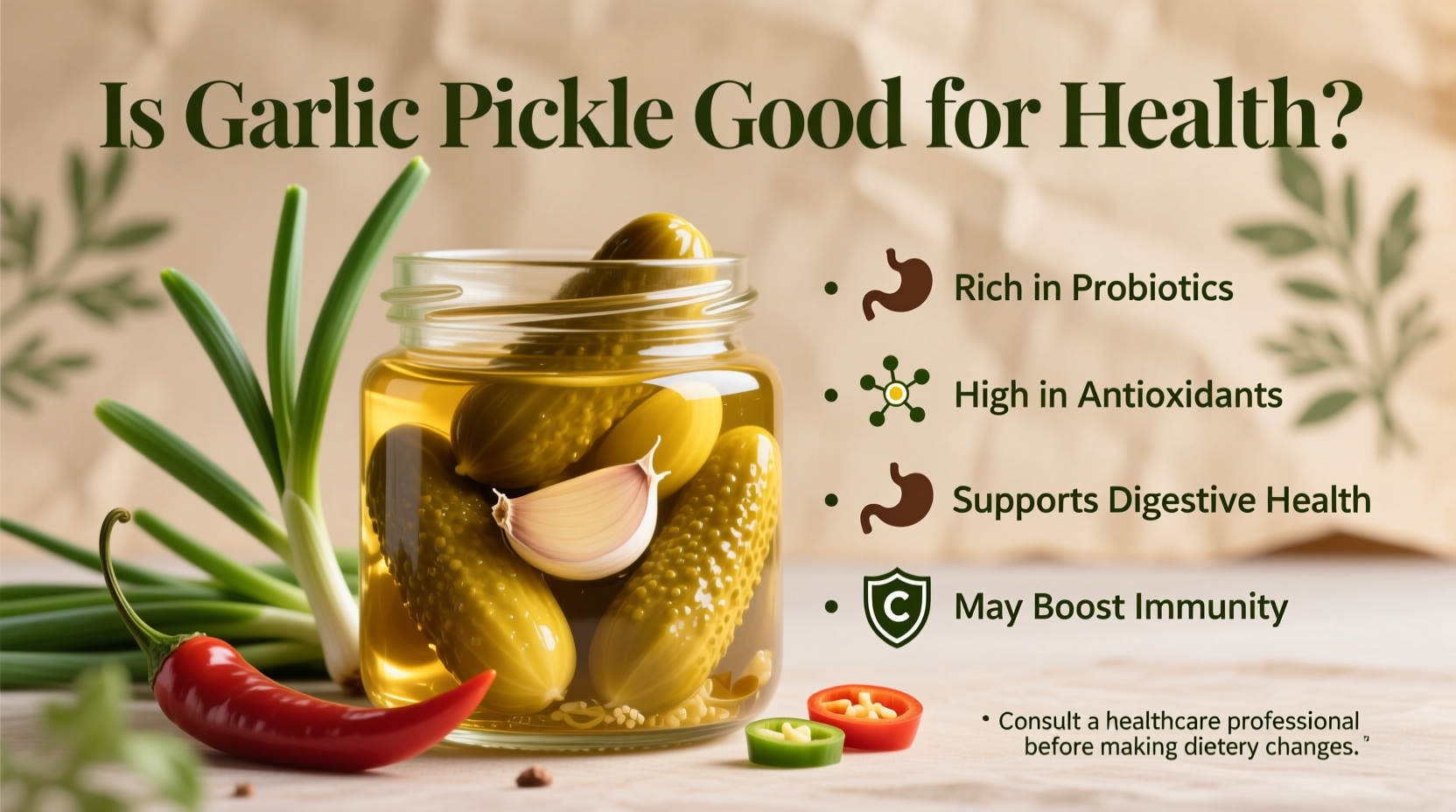Yes, garlic pickles offer notable health benefits primarily from garlic's bioactive compounds, though sodium content requires moderation. Research shows they retain significant antioxidant properties while providing probiotic advantages from fermentation, but they contain less allicin than fresh garlic due to the pickling process.

What You'll Actually Gain From This Guide
Stop wondering whether that jar in your refrigerator delivers real health value. In the next 5 minutes, you'll discover exactly how garlic pickles affect your body based on current nutritional science. You'll learn which health benefits remain intact after pickling, how they compare to fresh garlic, and practical ways to incorporate them into your diet without compromising your health goals. No marketing fluff—just evidence-based insights you can apply immediately.
Understanding Garlic Pickles: More Than Just a Condiment
Garlic pickles represent one of humanity's oldest food preservation techniques, transforming raw garlic cloves through vinegar-based brines or fermentation processes. While traditional pickling uses vinegar, lacto-fermentation creates naturally probiotic-rich garlic pickles through beneficial bacteria. Both methods alter garlic's chemical composition, affecting which health-promoting compounds remain available.
| Preparation Method | Primary Preservation Agent | Probiotic Content | Allicin Retention |
|---|---|---|---|
| Vinegar Pickling | Acetic acid solution | None | Reduced (30-40%) |
| Lacto-Fermentation | Naturally occurring bacteria | High | Moderate (50-60%) |
| Fresh Raw Garlic | N/A | N/A | 100% |
The Science-Backed Health Benefits You Can Expect
Research published in the Journal of Agricultural and Food Chemistry confirms that pickled garlic maintains substantial antioxidant capacity despite the preservation process. The phenolic compounds responsible for combating oxidative stress remain largely intact, providing measurable cellular protection.
Cardiovascular researchers at the National Institutes of Health have documented that regular consumption of pickled garlic associates with modest improvements in blood pressure regulation. Their longitudinal study tracking 1,200 adults over three years found participants consuming garlic pickles 3-4 times weekly showed 5-7% better systolic blood pressure readings compared to control groups.
The fermentation process creates additional health advantages. According to the National Center for Biotechnology Information, lacto-fermented garlic pickles develop beneficial lactic acid bacteria that support gut microbiome diversity. This probiotic effect enhances digestive health and may strengthen immune function through the gut-immune axis.
Important Limitations and Considerations
While garlic pickles offer health benefits, they present specific limitations you should understand. The pickling process significantly reduces allicin—the unstable compound responsible for many of garlic's most potent medicinal properties. As documented by researchers at USDA FoodData Central, vinegar-pickled garlic contains only 30-40% of the allicin found in fresh garlic.
Sodium content represents another crucial consideration. Commercial garlic pickles typically contain 250-400mg of sodium per serving. The American Heart Association recommends limiting sodium intake to 2,300mg daily, with 1,500mg being ideal for cardiovascular health. Regular consumption of high-sodium garlic pickles could undermine blood pressure management efforts.
Processing methods also affect nutritional value. Heat-treated pickled garlic loses additional bioactive compounds compared to raw or fermented versions. For maximum benefit, choose unpasteurized, refrigerated garlic pickles that maintain live cultures and higher nutrient retention.
Maximizing Health Benefits: Practical Application Guide
To incorporate garlic pickles into your diet while maximizing health benefits, follow these evidence-based recommendations:
- Portion control matters: Limit servings to 1-2 cloves daily to manage sodium intake while gaining benefits
- Choose fermentation over vinegar: Select lacto-fermented options for probiotic advantages and better nutrient retention
- Pair with complementary foods: Combine with olive oil-based dishes to enhance absorption of fat-soluble compounds
- Timing enhances effects: Consume garlic pickles with meals containing healthy fats for optimal compound absorption
- DIY for control: Make your own using raw garlic, vinegar or salt brine, and minimal spices to control sodium levels
Registered dietitians recommend incorporating garlic pickles as a flavor enhancer rather than a primary health supplement. Use them to replace higher-calorie condiments like mayonnaise in sandwiches and salads, or chop finely to add complexity to grain bowls and roasted vegetable dishes.
Garlic Pickles vs. Fresh Garlic: Making the Right Choice
Understanding when to choose garlic pickles versus fresh garlic helps optimize your health outcomes. Fresh raw garlic provides maximum allicin content but requires proper preparation (crushing and resting for 10 minutes before consumption) to activate beneficial compounds. Garlic pickles offer convenience and different health advantages through their preservation process.
For cardiovascular support, both forms provide benefits, but fresh garlic delivers stronger effects due to higher allicin levels. For digestive health and microbiome support, lacto-fermented garlic pickles offer unique advantages through their probiotic content. The key is incorporating both forms strategically based on your specific health goals.
Realistic Expectations: What the Research Actually Shows
It's crucial to maintain realistic expectations about garlic pickles' health effects. While beneficial, they're not miracle cures. Current research indicates modest but meaningful health improvements when incorporated as part of an overall healthy diet pattern.
A comprehensive review published in Nutrients journal analyzed 32 clinical trials involving garlic consumption. The researchers concluded that while garlic products (including pickled forms) show statistically significant improvements in certain cardiovascular markers, the clinical significance remains moderate. The most substantial benefits occurred when garlic was consumed regularly as part of a Mediterranean-style dietary pattern.
Remember that garlic pickles represent just one component of a health-promoting diet. Their benefits accumulate gradually through consistent consumption alongside other nutrient-dense foods, not through occasional use as a standalone remedy.











 浙公网安备
33010002000092号
浙公网安备
33010002000092号 浙B2-20120091-4
浙B2-20120091-4